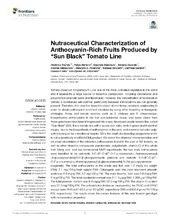| dc.contributor.author | Blando, Federica | |
| dc.contributor.author | Berland, Helge | |
| dc.contributor.author | Maiorano, Gabriele | |
| dc.contributor.author | Durante, Miriana | |
| dc.contributor.author | Mazzucato, Andrea | |
| dc.contributor.author | Picarella, Maurizio E. | |
| dc.contributor.author | Nicoletti, Isabella | |
| dc.contributor.author | Gerardi, Carmela | |
| dc.contributor.author | Mita, Giovanni | |
| dc.contributor.author | Andersen, Øyvind M | |
| dc.date.accessioned | 2020-04-22T13:35:25Z | |
| dc.date.available | 2020-04-22T13:35:25Z | |
| dc.date.issued | 2019-08-28 | |
| dc.Published | Blando F, Berland HÅ, Maiorano G, Durante, Mazzucato, Picarella, Nicoletti, Gerardi C, Mita, Andersen ØM. Nutraceutical characterization of anthocyanin-rich fruits produced by «Sun Black» tomato line. Frontiers in Nutrition. 2019;6:133 | eng |
| dc.identifier.issn | 2296-861X | en_US |
| dc.identifier.uri | https://hdl.handle.net/1956/21975 | |
| dc.description.abstract | Tomato (Solanum lycopersicum L.) is one of the most cultivated vegetable in the world and it represents a large source of bioactive compounds, including carotenoids and polyphenols (phenolic acids and flavonoids). However, the concentration of flavonoids in tomato is considered sub-optimal, particularly because anthocyanins are not generally present. Therefore, this crop has been the object of an intense metabolic engineering in order to obtain anthocyanin-enriched tomatoes by using either breeding or transgenic strategies. Some wild tomato species, such as S. chilense and S. cheesmaniae, biosynthesize anthocyanins in the fruit sub-epidermal tissue, and some alleles from those genotypes have been introgressed into a new developed purple tomato line, called “Sun Black” (SB). It is a tomato line with a purple skin color, both in green and in red fruit stages, due to the biosynthesis of anthocyanins in the peel, and a normal red color pulp, with a taste just like a traditional tomato. SB is the result of a breeding programme and it is not a genetically modified (GM) product. We report the chemical characterization and structure elucidation of the attractive anthocyanins found in the peel of SB tomato, as well as other bioactive compounds (carotenoids, polyphenols, vitamin C) of the whole fruit. Using one- and two-dimensional NMR experiments, the two main anthocyanins were identified to be petunidin 3-O-[6″-O-(4‴-O-E-p-coumaroyl-α-rhamnopyranosyl) -β-glucopyranoside]-5-O-β-glucopyranoside (petanin) and malvidin 3-O-[6″-O-(4‴-O-E-p-coumaroyl-α-rhamnopyranosyl)-β-glucopyranoside]-5-O-β-glucopyranoside (negretein). The total anthocyanins in the whole ripe fruit was 1.2 mg/g dry weight (DW); 7.1 mg/100 g fresh weight (FW). Chlorogenic acid (the most abundant phenolic acid) was 0.6 mg/g DW; 3.7 mg/100 g FW. The main flavonol, rutin was 0.8 mg/g DW; 5 mg/100 g FW. The total carotenoid content was 211.3 μg/g DW; 1,268 μg/100 g FW. The total phenolic content was 8.6 mg/g DW; 52.2 mg/100 g FW. The vitamin C content was 37.3 mg/100 g FW. The antioxidant activities as measured by the TEAC and ORAC assays were 31.6 and 140.3 μmol TE/g DW, respectively (193 and 855.8 μmol TE/100 g FW, respectively). The results show the unique features of this new tomato genotype with nutraceutical properties. | en_US |
| dc.language.iso | eng | eng |
| dc.publisher | Frontiers | en_US |
| dc.rights | Attribution CC BY | eng |
| dc.rights.uri | http://creativecommons.org/licenses/by/4.0/ | eng |
| dc.title | Nutraceutical characterization of anthocyanin-rich fruits produced by «Sun Black» tomato line | en_US |
| dc.type | Peer reviewed | |
| dc.type | Journal article | |
| dc.date.updated | 2019-11-15T12:21:23Z | |
| dc.description.version | publishedVersion | en_US |
| dc.rights.holder | Copyright 2019 Blando, Berland, Maiorano, Durante, Mazzucato, Picarella, Nicoletti, Gerardi, Mita and Andersen. | en_US |
| dc.identifier.doi | https://doi.org/10.3389/fnut.2019.00133 | |
| dc.identifier.cristin | 1737574 | |
| dc.source.journal | Frontiers in Nutrition | |
| dc.identifier.citation | Frontiers in Nutrition. 2019, 6, 133. | |

